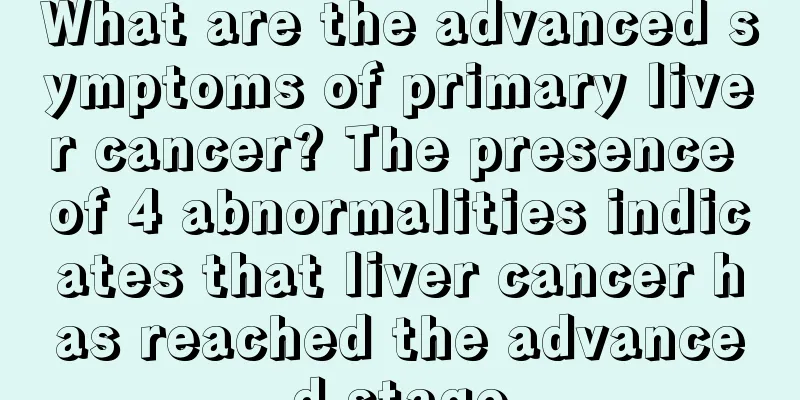How to prevent liver cancer rupture and bleeding

|
Primary liver cancer rupture and bleeding is a common, serious and fatal complication of liver cancer patients, and one of the main causes of death in liver cancer patients, accounting for 9% to 10% of liver cancer deaths and ranking fourth among liver cancer deaths. Because the disease develops suddenly and rapidly, and is often accompanied by shock, it is difficult to treat and has a poor prognosis. If not actively treated, most patients die quickly. 1. Mechanism of occurrence The mechanism of spontaneous rupture and bleeding of liver cancer is not yet fully understood. Most scholars believe that it is due to direct invasion of the tumor, which causes venous outflow obstruction, causing venous hypertension, and thus bleeding and rupture. In general, it may be related to the following factors: liver cancer is highly malignant and grows rapidly, which leads to a relative lack of blood supply to the tumor, resulting in central ischemia, necrosis and liquefaction. If the tumor volume increases too quickly at this time and the tumor capsule cannot stretch, it may cause the surface of the tumor to rupture and cause bleeding; liver cancer ischemia, necrosis and secondary infection can also lead to rupture and bleeding; the tumor directly invades the intrahepatic blood vessels, causing vascular rupture and bleeding; after the portal vein is embolized by cancer thrombus, the superficial tumor peripheral part has nutritional necrosis and rupture, which can also lead to bleeding. When the tumor is located in the superficial position of the liver septum, it is susceptible to external impact. The thin tumor capsule and the extremely fragile cancer tissue are also the causes of rupture and bleeding. Rupture and bleeding of liver cancer are more common in nodular and mass-type liver cancer, especially those with cirrhosis, and diffuse liver cancer is rare. There are two types of rupture and bleeding in liver cancer: one is bleeding under the liver capsule, and the other is bleeding through the capsule into the abdominal cavity. The latter progresses rapidly and has a very high mortality rate. 1. During the growth process of liver cancer, due to its expansive growth, the intratumoral pressure is high. At the same time, due to the rapid growth of the tumor, its blood supply is relatively insufficient, resulting in ischemia and hypoxia, necrosis and liquefaction in the center of the tumor, and corrosion of blood vessels. On the basis of tumor congestion, high internal pressure and necrosis, when the intra-abdominal pressure increases due to deep breathing, turning over, vibration, severe coughing, forceful defecation or physical examination, the intratumoral pressure breaks through the tumor capsule or the normal weak liver tissue ruptures, causing massive intra-abdominal bleeding. 2. In patients with portal hypertension in cirrhosis, the liver tumor is surrounded by a venous system that supplies blood, and the portal vein is connected to the hepatic vein by a communicating branch. When the portal vein pressure increases, the pressure in the arteries and veins also increases, causing the blood vessel walls to gradually become thinner, eventually leading to rupture and bleeding. Patients with rupture and bleeding in liver cancer often have cirrhosis, with a complication rate of more than 90%, which is higher than the complication rate of cirrhosis in liver cancer patients without rupture and bleeding. 3. Infection, tumor growth, erosion and destruction of blood vessels after tumor necrosis and liquefaction are also important factors for rupture and bleeding of liver cancer. 4. Liver cancer is often accompanied by cirrhosis, liver function damage, and abnormal coagulation mechanism, which is one of the causes of liver cancer rupture and bleeding. 2. Clinical manifestations 1. General manifestations of liver cancer Hepatomegaly, pain in the liver area, varicose veins of the abdominal wall, weight loss, low-grade fever, jaundice, elevated serum AFP, etc. Some patients have been diagnosed with liver cancer or are receiving treatment before liver cancer ruptures and bleeds, and a small number of patients have rupture and bleeding as the first symptom. (II) Bleeding manifestations Subcapsular hemorrhage in the liver manifests as sudden pain in the liver area, rapid enlargement of the right upper abdominal mass, tenderness in the liver area and local hypertrophy and tension, which may be accompanied by nausea, vomiting, pale complexion, cold sweat, dizziness, palpitations, rapid pulse, and decreased blood pressure, which are manifestations of insufficient blood volume. If the ruptured liver cancer is small and the bleeding is slow, there may be no manifestation of insufficient blood volume, or only localized mild pain in the liver area, which will be relieved after 3-5 days. If the liver cancer ruptures and penetrates the capsule into the abdominal cavity, it will manifest as sudden severe pain in the upper abdomen, which will then be relieved and spread to the whole abdomen, accompanied by acute bleeding and peritonitis, such as abdominal pain, abdominal distension, nausea, vomiting, pale complexion, cold sweat, rapid pulse, abdominal muscle tension, positive mobile dullness, and the patient will quickly enter a state of shock. 3. Diagnosis The diagnosis of this disease is generally not difficult, especially for patients with a clear diagnosis of liver cancer and a large amount of bleeding. If the amount of bleeding is small, the diagnosis is more difficult. Liver cancer patients with a history of cirrhosis should be alert to the possibility of this disease when they suddenly experience right upper abdominal pain or hemorrhagic shock and diffuse peritonitis after exertion. Diagnostic abdominal puncture, CT, B-ultrasound and other examinations, especially diagnostic abdominal puncture, are of great significance for the diagnosis of this disease. Therefore, for patients with unexplained abdominal pain, abdominal distension, and peritoneal irritation signs, diagnostic abdominal puncture should be performed. For patients whose liver cancer diagnosis has not yet been clearly determined, those with sudden onset of abdominal distension, abdominal pain accompanied by peritoneal irritation signs and shock should undergo abdominal B-ultrasound, CT, angiography and diagnostic abdominal puncture to determine whether there are space-occupying lesions in the liver and ruptured bleeding of liver cancer. The diagnosis of this disease can refer to the following diagnostic criteria: 1. There are severe signs of liver damage and AFP is positive. 2. Non-coagulated blood is drawn from the abdominal cavity, and the positive rate can reach 100%. AFP bile analysis, amylase determination, or cancer cell examination of the abdominal puncture fluid can be positive. 3. The hemoglobin level decreases progressively and is often below 90g/L. 4. Ultrasound, CT and hepatic artery angiography can reveal tumor rupture and intra-abdominal bleeding IV. Treatment Rupture and bleeding of tumors are often sudden and dangerous, requiring immediate rescue. At the same time or after the condition stabilizes, treatment for the primary lesion in the liver should be actively considered. 1. Non-surgical treatment 1. Emergency treatment for patients with less bleeding. The patient should lie flat to rest, limit activities, and apply pressure bandage with abdominal bandage. For patients with heavy bleeding and hemorrhagic peripheral circulatory failure, the patient's blood pressure, pulse, respiration, heart rate and consciousness should be closely monitored in time, and anti-shock treatment should be given. 2. To replenish blood volume: Patients with minor bleeding may only need to be given crystalloid fluid. Patients with heavy bleeding and hemorrhagic peripheral circulatory failure should be given fresh blood transfusion or component blood transfusion in a timely manner. (ii) Surgical treatment The disease is serious and has a high mortality rate. Anyone who meets the surgical indications should undergo surgery immediately. Indications for surgery: (1) The patient is in good general condition and under 60 years old; (2) It is clear that the patient has ruptured and bled liver cancer, accompanied by shock and a rapid drop in hemoglobin within a short period of time; (3) Other causes of bleeding cannot be ruled out, or other acute abdomen requires surgical exploration; (4) The liver's compensatory function is still good, especially in the case of hepatic encephalopathy. Patients with large amounts of ascites or other major organ dysfunction are expected to be able to undergo tumor resection or other effective treatments. (III) Traditional Chinese Medicine Treatment The disease has an acute onset, is severe, and has a high mortality rate, and it is rare to be treated with traditional Chinese medicine. |
<<: What to eat to prevent liver cancer
>>: How to prevent liver cancer recurrence
Recommend
What is the biggest cause of lung cancer? To prevent lung cancer, you should pay attention to these
Smoking is one of the main causes of lung cancer,...
How to treat breast cancer metastasis
No matter what kind of cancer it is, if it metast...
How long can a patient with advanced lung cancer and low white blood cell count live?
How long can a patient with advanced lung cancer ...
How to eliminate termites
As the saying goes, know yourself and know your e...
My waist hurts when I squat or bend over
Some people may find themselves with this problem...
Is it good for pregnant women to eat quail eggs?
Many pregnant women need to pay special attention...
Briefly outline the causes of rectal cancer
Rectal cancer does not occur suddenly, but is the...
What are the treatments for laryngeal stones?
When the throat becomes inflamed, many people do ...
What's the matter with the red spots on the instep
The feet are an important part of our body. Somet...
Keep in mind six methods to prevent ovarian cancer
Ovarian cancer is a malignant tumor that seriousl...
My stomach hurts after eating persimmons
Everyone's gastrointestinal conditions are di...
What to do if your legs are not smooth and have chicken skin
Generally speaking, most people have chicken skin...
What kind of stew is good to drink after lung surgery?
Lung surgery is also a relatively common surgical...
Pain in the thigh when walking
When people walk normally, they need the cooperat...
What to eat for invasive breast cancer
What to eat for invasive breast cancer? Patients ...









